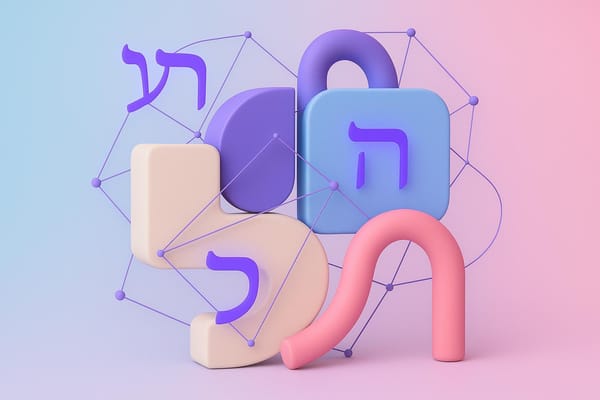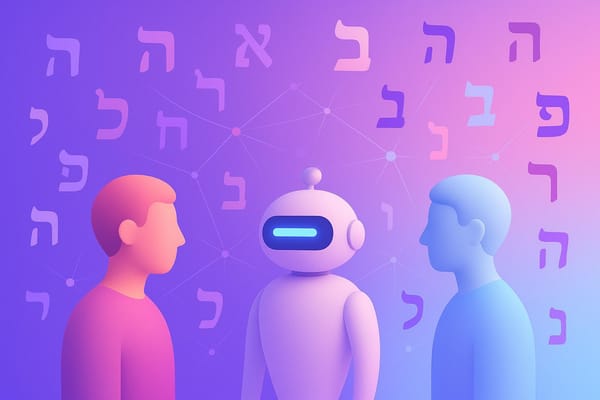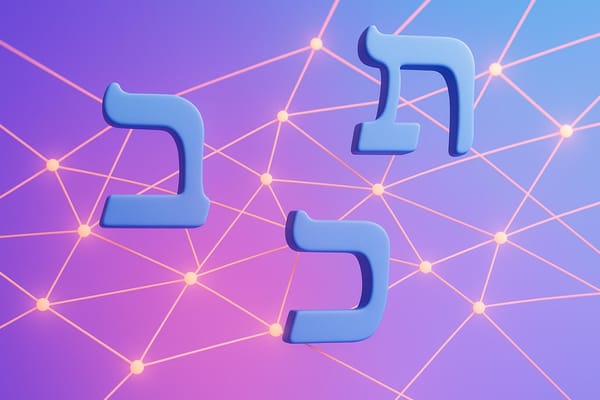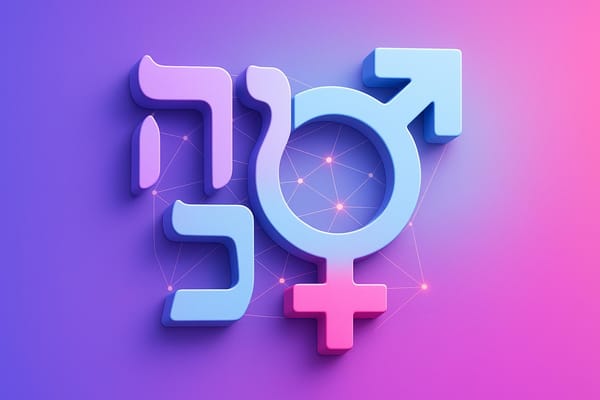How AI Tracks Hebrew Grammar Evolution
Explore how AI is revolutionizing the study of Hebrew grammar, tracing its evolution and enhancing learning through advanced tools and methods.
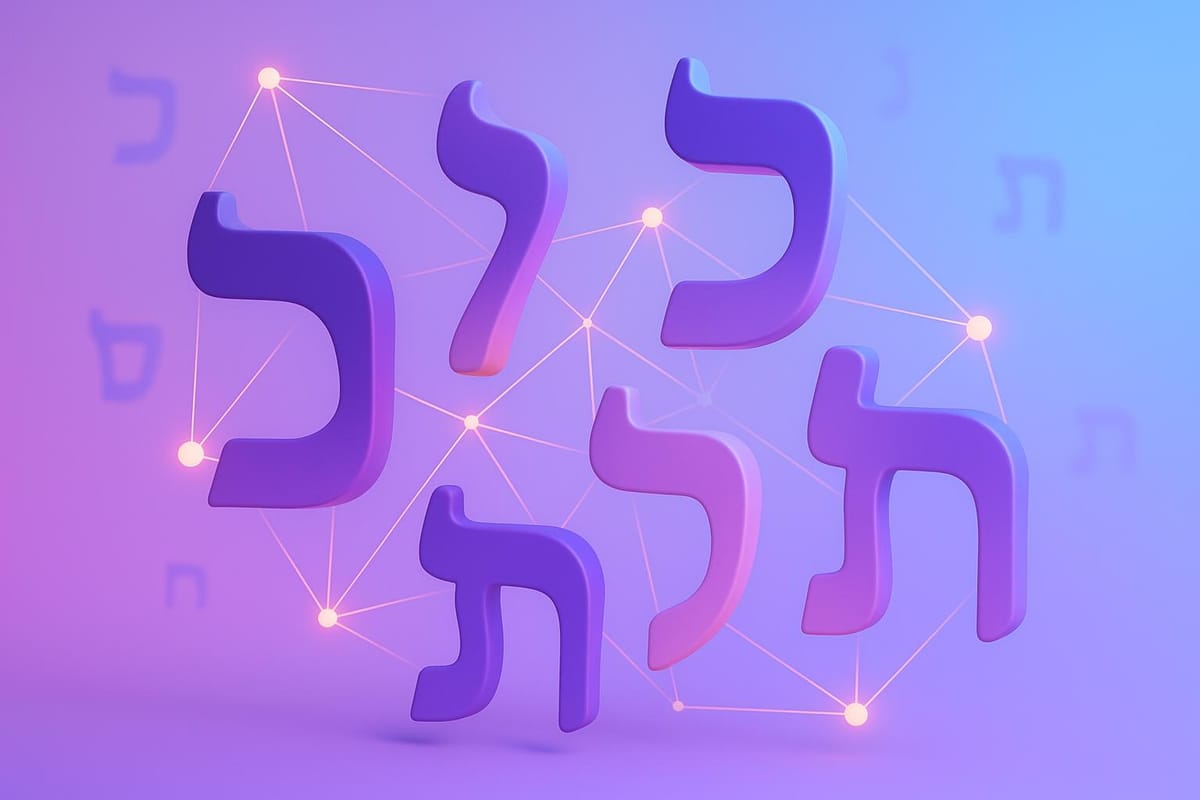
Before you dive in, check out baba — our context-aware Hebrew translation app for iOS and Android. Baba understands who you are and who you’re talking to, handles slang, gender, and plurality, and delivers natural Hebrew every time.
AI is transforming how we study Hebrew grammar, from its Biblical roots to its modern form. Here's the key takeaway: AI tools analyze massive datasets to identify shifts in grammar, pronunciation, and sentence structure, helping both researchers and learners understand Hebrew's evolution.
Key Insights:
- Grammar Evolution: Modern Hebrew shifted from Biblical VSO (Verb-Subject-Object) to SVO (Subject-Verb-Object), similar to English.
- AI's Role: Tools like LSTM and BERT analyze texts, track linguistic changes, and provide real-time updates on grammar trends.
- Learning Impact: AI-powered platforms improve vocabulary retention by 30% and provide personalized feedback on grammar and pronunciation.
- Speech Analysis: AI studies spoken Hebrew using datasets like "ivrit.ai" (3,300+ hours of recordings), linking pronunciation to grammar changes.
- Translation Precision: Apps like "baba" adjust translations based on gender, plurality, and context, ensuring accuracy in daily use.
AI doesn't just analyze text - it also supports learners and researchers by providing instant feedback, context-aware translations, and insights into how Hebrew continues to develop.
AI Methods for Studying Hebrew Grammar Changes
AI uses three interconnected approaches to track the evolution of Hebrew grammar and keep translation tools up to date. Let’s take a closer look at how AI breaks down Hebrew words, analyzes sentence structures, and examines spoken language to understand these changes.
Word Structure Analysis: How AI Breaks Down Hebrew Words
Hebrew's word structure is rooted in a unique system of morphology that revolves around a three-consonant root, known as the "shoresh". This system can be challenging to analyze, but it also provides AI with a clear framework to identify patterns. By processing thousands of examples at once, AI can pinpoint how prefixes, suffixes, and infixes shift over time, revealing trends in word usage.
AI also studies verb conjugation patterns, or "binyanim", which are groups of verbs that follow specific conjugation rules. The same root can appear in multiple binyanim, each carrying a different meaning. By examining historical texts and modern language, AI tracks how these patterns evolve. Using machine learning, AI assigns probabilities to word sequences and updates its understanding of Hebrew morphology as it processes more data.
This continual analysis allows AI to detect even subtle shifts in grammar, making it a powerful tool for adapting translations to Hebrew's changing linguistic landscape.
Sentence Structure and Meaning Analysis
AI systems like LSTM, BERT, and GPT2 excel at mapping Hebrew sentence structures. These deep learning models perform tasks such as syntax tree analysis, morphological tagging, and semantic analysis, helping researchers understand how sentence meanings have evolved.
By identifying semantic patterns in texts, AI uncovers nuances that traditional methods might overlook. Natural Language Processing (NLP) advancements have significantly enhanced AI's ability to track these changes. This is especially important as Hebrew continues to adapt its ancient grammatical structures to fit modern communication styles.
AI-driven tools also enhance this process by quickly analyzing the grammatical roles of words within sentences. This capability ensures that AI remains a valuable resource for understanding Hebrew's ongoing linguistic transformation.
Sound and Pronunciation Analysis
AI doesn’t just focus on written Hebrew - it also analyzes spoken language to uncover how pronunciation influences grammar. Changes in pronunciation can alter grammatical usage, and AI tools are becoming increasingly adept at detecting these shifts. By studying phonetics and phonology, AI links pronunciation changes to evolving grammatical patterns.
The development of extensive Hebrew speech datasets, such as "ivrit.ai", which includes over 3,300 hours of recorded speech, has been a game-changer in this area. Using these datasets, AI can break down spoken words into their roots and affixes, showing how pronunciation impacts word formation and conjugation.
Automated Speech Recognition (ASR) technology has also advanced significantly for Hebrew, enabling AI to analyze spoken language in real time. This provides valuable insights into pronunciation trends and their connection to grammar. For instance, unclear sounds in rapid speech may lead speakers to adjust grammatical structures for better clarity. By integrating speech data, AI offers a more complete picture of how Hebrew grammar continues to evolve.
Want to stay updated? Join the waitlist for our mobile app at www.itsbaba.com.
AI Tools That Adapt to Modern Hebrew
Modern AI tools have taken a leap forward by adapting to the evolving nature of Hebrew. They continuously learn from how Hebrew is used in everyday life, refining their capabilities in real time. Let’s explore how these tools are shaping the analysis of spoken Hebrew and its grammar.
Speech Recognition for Modern Hebrew
Speech recognition technology has become a key player in understanding spoken Hebrew. These systems analyze speech patterns to uncover how pronunciation impacts grammar and meaning. They provide instant feedback on pronunciation, helping users speak more naturally while keeping up with how the language is changing in daily conversations.
Here’s how it works: the technology compares spoken words against massive databases of Hebrew speech patterns. When it detects pronunciation differences that might affect grammar, it adjusts its understanding. This ensures that translation tools remain aligned with the way Hebrew is spoken across various regions and social groups.
Additionally, these systems monitor how rapid or unclear speech can lead to grammatical shifts. By studying these trends, AI tools can anticipate and adapt to new pronunciation styles that influence Hebrew grammar.
Smart Translation Based on Context
Context-aware AI translation has transformed Hebrew language processing. These advanced systems go beyond translating words - they analyze the entire communication context, considering factors like the speaker, the audience, and the setting.
Using neural networks, these tools tokenize and encode Hebrew text to grasp its deeper meaning. This approach allows AI to account for cultural subtleties in Hebrew, making it particularly effective for creative or nuanced content.
By combining neural processing with standardized translation memory, these systems ensure both accuracy and consistency across documents and conversations. Machine learning algorithms, trained on extensive Hebrew language datasets, enable these tools to understand grammar and syntax in ways that reflect how the language is used today.
The translation industry has embraced these advancements, blending AI’s capabilities with human expertise for complex tasks. These contextual insights also enhance personalized language learning, which we’ll explore next.
AI Grammar Learning Tools
AI-powered platforms are revolutionizing Hebrew grammar education by tailoring learning experiences to each individual. These tools create customized learning paths that adapt based on a user’s progress, focusing on areas that need the most improvement.
With the help of data analytics, these platforms highlight a learner’s strengths and weaknesses, offering targeted instruction that aligns with modern Hebrew grammar patterns. Interactive exercises and real-life scenarios make vocabulary retention more effective. AI chatbots act as virtual tutors, providing practical language practice while exposing learners to contemporary Hebrew usage.
Interestingly, 70% of users who used AI tools for learning Hebrew reported gaining a deeper understanding of the language’s nuances.
What makes these tools stand out is their ability to stay updated with current Hebrew usage. This ensures that students learn grammar and vocabulary that reflect how the language is spoken and written today. By combining personalized feedback, engaging activities, and real-world context, AI grammar tools are making it easier than ever to master modern Hebrew.
Want to stay ahead in learning Hebrew? Join the waitlist for our mobile app at www.itsbaba.com.
Case Study: baba - Smart Hebrew Translation
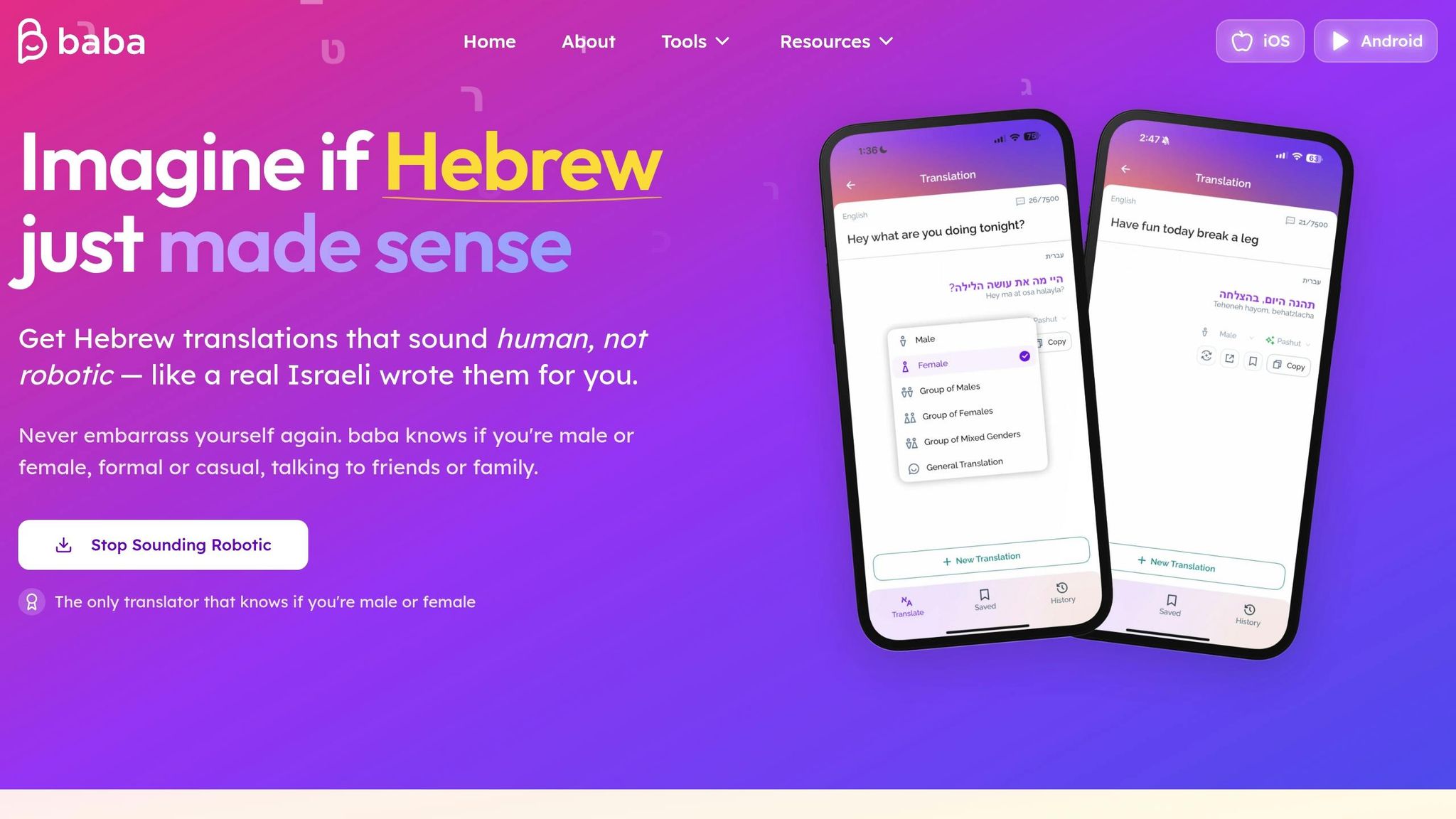
baba takes AI's linguistic capabilities and applies them directly to Hebrew translation, showcasing how modern technology meets the challenges of a language with unique and evolving grammar rules. By leveraging advanced AI models, baba stands out as a practical example of how translation tools can adapt to the complexities of Hebrew.
How baba Handles Gender and Plurality
One of baba's standout features is its ability to account for gender and plurality - key elements of Hebrew grammar. For example, when translating "I am going to the store", most translators default to the masculine form, "אני הולך לחנות." baba, however, adjusts for context, providing "אני הולכת לחנות" for female speakers. Similarly, for "They liked the movie", baba distinguishes between "הם אהבו את הסרט" for mixed groups and "הן אהבו את הסרט" for all-female groups. Even a simple question like "Are you coming?" is tailored: baba offers "אתה בא?" for a man, "את באה?" for a woman, "אתם באים?" for mixed groups, and "אתן באות?" for multiple women. This level of precision ensures translations are accurate and respectful of Hebrew's grammatical nuances.
Custom Translations Based on User and Context
baba goes beyond standard translations by adapting to the user's identity and context. During setup, users can specify their gender and typical audience, allowing the app to automatically adjust translations to suit both the speaker and the listener. The system also captures slang and everyday expressions, making translations feel natural and conversational. As iowitz shared:
"This app translates properly when you're speaking to men, women and really just anyone. It also accounts for slang and expressions that any other translator would not translate properly. Really cool!" - iowitz
By focusing on how Hebrew is spoken in real-life situations, baba ensures its translations are not only accurate but also practical for daily use.
baba's Main AI Features
baba relies on specialized AI models to deliver precise and context-aware translations. For instance, its "Mahir m1.5" model focuses on contextual understanding, while "Chacham c1.5" ensures accuracy in gender and tone. Both models debuted in version 1.1.1, released in June 2025. This dual-model system allows users to choose between faster translations or more in-depth results, depending on their needs. Additional features include smart language detection, voice-to-text functionality powered by AI, and seamless two-way translation between English and Hebrew.
The app has been well-received, earning a 5.0 rating on the App Store for its speed and reliability. As Settonsamuel noted:
"Great app for quick, accurate Hebrew translations... It's simple, reliable, and the easiest to use. No other translation app competes." - Settonsamuel
Features like translation history further highlight baba's ability to handle Hebrew's evolving grammar while offering practical tools for everyday users.
Want to try it out? Join the waitlist for the baba mobile app at www.itsbaba.com.
Conclusion: AI's Impact on Hebrew Grammar Evolution
Artificial intelligence is reshaping how we approach and understand the evolution of Hebrew grammar. By analyzing extensive text data and identifying patterns, AI uncovers insights that would have taken scholars years to discover.
The results speak for themselves: 70% of users leveraging AI tools in Biblical studies report a deeper understanding, while AI-assisted learners experience a 30% improvement in vocabulary retention compared to traditional methods. These numbers highlight how AI not only enhances comprehension but also makes learning Hebrew more efficient.
AI's ability to dissect complex Hebrew text structures and provide detailed syntactical and grammatical insights has transformed language processing. Deep learning models now reveal subtle semantic patterns and linguistic nuances that often escape human analysis. Beyond translation, AI plays a vital role in helping historians reconstruct ancient texts and can even be applied to other morphologically rich languages. These advancements make AI tools indispensable for both academic and practical applications.
Moreover, AI tools offer 24/7 support, delivering contextual understanding, identifying grammatical errors, and providing instant feedback - tasks that once required years of dedicated study. Tools like baba exemplify how AI can preserve the intricacies of Hebrew grammar while adapting to its ongoing evolution. By addressing elements like gender, plurality, and context, these tools ensure that Hebrew’s linguistic richness and cultural significance remain intact.
The combination of preservation and modernization positions Hebrew for a promising future. AI enhances our ability to document, teach, and understand Hebrew grammar, ensuring that the language remains vibrant and accessible for generations to come. By bridging the gap between traditional scholarship and modern communication, AI proves that technology can honor linguistic heritage while embracing progress.
Get on the waitlist for our mobile app at www.itsbaba.com
FAQs
How does AI help track changes in Hebrew grammar over time?
AI tools like LSTM and BERT are making a significant impact in studying the evolution of Hebrew grammar by identifying and interpreting intricate language patterns. LSTMs (Long Short-Term Memory networks) are particularly well-suited for handling sequential data, which makes them effective at analyzing shifts in Hebrew grammar, such as evolving verb conjugations or changes in sentence structure over time.
On the other hand, BERT, especially Hebrew-specific models like HeBERT, specializes in grasping the context and morphological nuances of the language. This capability helps AI pinpoint subtle grammatical changes and produce translations that are both precise and contextually aware. These advancements pave the way for smarter tools that make Hebrew communication smoother and translations more natural.
Want to stay updated? Join the waitlist for our mobile app at www.itsbaba.com.
How does AI help Hebrew learners remember vocabulary and improve their skills?
AI makes learning Hebrew more effective by tapping into spaced repetition algorithms. These algorithms work by scheduling reviews of vocabulary at specific intervals, just before you're likely to forget the material. This technique helps cement words in your memory while keeping the learning process efficient.
On top of that, AI offers real-time, personalized feedback to address mistakes and adjust to your individual learning pace. By tailoring corrections and guidance, it boosts confidence and helps learners grasp Hebrew grammar and vocabulary with greater ease.
How does AI manage Hebrew's complex gender and plural rules in translations like baba?
AI in baba navigates Hebrew's complex gender and plural structures with precision by carefully considering context, the dynamics between the speaker and listener, and the desired tone. This approach ensures translations are not only grammatically correct but also feel natural and culturally aligned.
By paying attention to these subtleties, baba provides translations that transcend simple word-for-word accuracy, enabling smooth communication in Hebrew - whether you're engaging in casual conversations, conducting business, or expressing yourself in cultural contexts.


